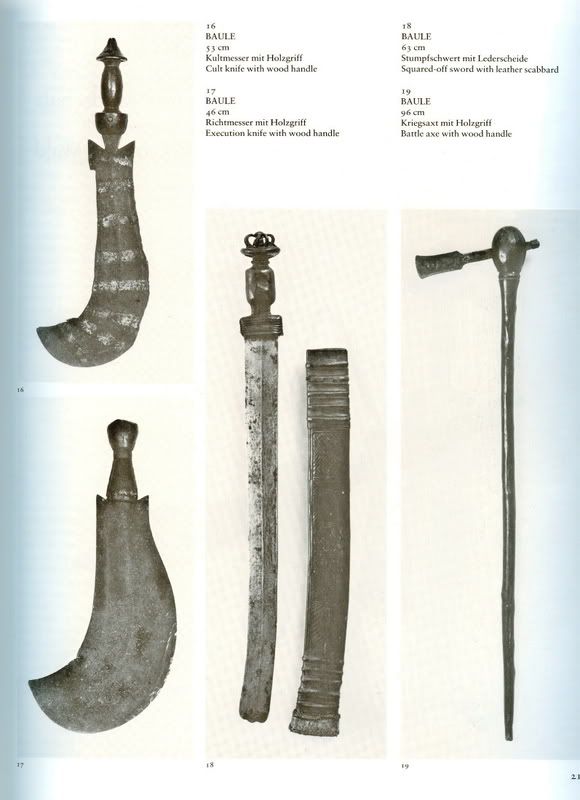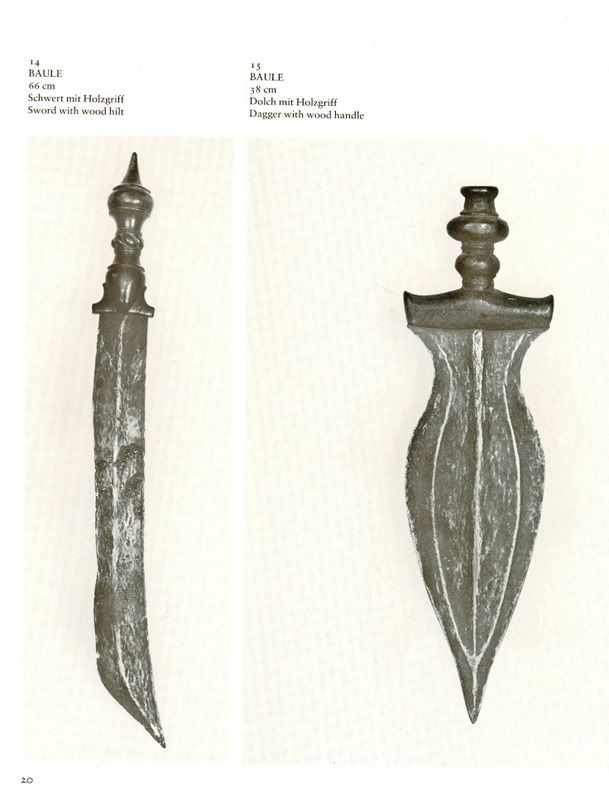
 |
|
|
#1 |
|
Member
Join Date: Mar 2005
Location: USA Georgia
Posts: 1,599
|
Possibly used by alll three?
26.5 inches OAL 67 cm Comments? |
|
|

|
|
|
#2 |
|
Member
Join Date: Dec 2004
Location: Sint-Amandsberg (near Ghent, Belgium)
Posts: 830
|
I don't think it's Baule, Bill
Here are some pics of Baule swords and knives from the book 'Afrikanische Waffen / African Weapons' by Werner Fischer and Manfred A. Zirngibl (1978)  
|
|
|

|
|
|
#3 |
|
Member
Join Date: May 2008
Location: Czech Republic
Posts: 847
|
This kind of swords use to be designated to Mandingo/Malinke tribes in literature
|
|
|

|
|
|
#4 |
|
Member
Join Date: Mar 2005
Location: USA Georgia
Posts: 1,599
|
Thanks, guys. I have a Baule sword. One of my favorite pieces and it is quite different. Looks like those in Freddy's pictures.
I have an interesting Baule dagger on the way to me. Will post some pics when I get it. I like different cultures, be it Philippines, African, India, or SEA. Here is the Baule sword. I may have posted it before, not sure. |
|
|

|
|
|
#5 |
|
Member
Join Date: May 2008
Location: Czech Republic
Posts: 847
|
This Baule sword is really brilliant
|
|
|

|
|
|
#6 | |
|
Member
Join Date: Mar 2005
Location: USA Georgia
Posts: 1,599
|
Quote:
Thank you Martin. 
|
|
|
|

|
|
|
#7 |
|
Arms Historian
Join Date: Dec 2004
Location: Route 66
Posts: 10,743
|
I will echo Martin's note on Bill's sword from Baule...absolutely magnificent! Thank you for the wonderful photos Bill. The shells intact on the scabbard are outstanding, and amazing to see these intact like this.
Regarding the sword posted, which is in the familiar mounts attributed to the Mandingo in Mali, with beautiful leather work and the distinct discs and the guardless hilt, it is quite possible these may have diffused of course to other regions to the west. It has been a personal holding of mine that there are distinct associations between these mounts and the equally distinct Omani 'kattara', whose influence may well have entered these regions in my opinion via the trade routes. In research some time ago this diffusion from Omani trade in Zanzibar that extended as far as Morocco and throughout trade centers across the Sahara became quite apparant. While the Baule are a distinct tribal group to the west, it is important to observe that 'Malinke' is a variant term applied to the 'Mandingo' (also Manding, Mandin, Mande). Some years ago I knew a Fulani gentleman who was from Guinea, and in showing him an illustration of one of these sabres, he immediately recognised it and promptly referred to it (in Fulani) as a 'kota', this being the apparant term in Fulani for sword (probably generally applied). With this, it became clear that there was some degree of diffusion to the west of these disctinctly mounted sabres, and it would be as difficult to geographically assign them as many African weapon forms. In general, these remain primarily considered Mandingo weapons, and from regions in Mali. These were of course invariably mounted with European sabre blades of 19th century, and most typically French with the colonial presence there. All best regards, Jim |
|
|

|
|
|
#8 | |
|
Arms Historian
Join Date: Dec 2004
Location: Route 66
Posts: 10,743
|
Quote:
Martin, which literature are you citing? I am looking for references to the Mandingo. |
|
|
|

|
|
|
#9 |
|
Member
Join Date: Dec 2004
Location: What is still UK
Posts: 5,939
|
Bill could show that Baule sword three times a day for the next ten years and I would still not be tired of looking at it. So graceful, very clever simplicity with strong decoration which sounds a contradiction but its there.

|
|
|

|
|
|
#10 |
|
Arms Historian
Join Date: Dec 2004
Location: Route 66
Posts: 10,743
|
Yup, its a nice sword.
The one posted on this thread is nice too, |
|
|

|
|
|
#11 |
|
Member
Join Date: May 2008
Location: Czech Republic
Posts: 847
|
Jim, I ment e.g."Afrikanische Waffen" by Werner Fischer und Manfred Zirngibl, page 22
|
|
|

|
|
|
#12 | |
|
Arms Historian
Join Date: Dec 2004
Location: Route 66
Posts: 10,743
|
Quote:

|
|
|
|

|
|
|
#13 | |
|
Member
Join Date: Mar 2005
Location: USA Georgia
Posts: 1,599
|
Quote:
|
|
|
|

|
|
|
#14 |
|
Arms Historian
Join Date: Dec 2004
Location: Route 66
Posts: 10,743
|
I agree Tim.
|
|
|

|
|
|
#15 |
|
Member
Join Date: Aug 2007
Posts: 293
|
Such a stunning Baule sword !!! The shells are fantastic!
|
|
|

|
|
|
#16 | |
|
Arms Historian
Join Date: Dec 2004
Location: Route 66
Posts: 10,743
|
Quote:
|
|
|
|

|
|
|
#17 |
|
Member
Join Date: Mar 2005
Location: USA Georgia
Posts: 1,599
|
Ok, folks, I just got another Baule sword. Older, not in as good condition. Iron hilt. Will make another thread.
|
|
|

|
 |
|
|